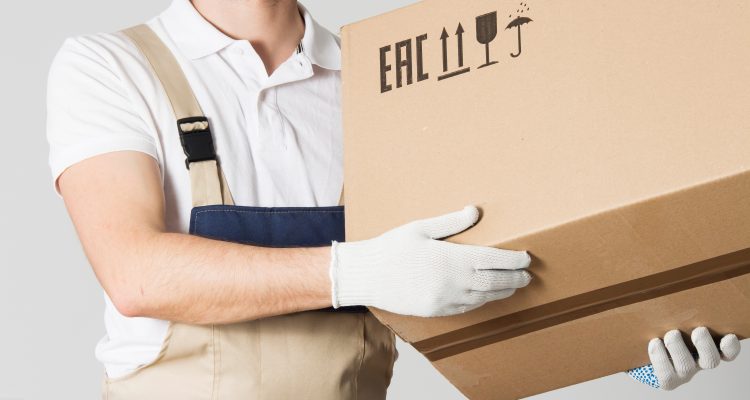
China and dishes: Place a 7-10 cm (3”-4”) layer of crushed paper in the bottom of a sturdy carton. Place several layers of wrapping paper on your work table. Place one plate on the paper and fold the corner of one or two sheets diagonally over the plate. Place another plate on top and fold another piece of paper over it. Add two more plates in the same manner. Fold the sides of the paper over the bundle and roll the plates, keeping the sides of the paper straight for a neat bundle. Place bundles ON EDGE in the carton and pack them snug. When you have completed a layer in the carton, place another layer of crushed paper over it. Fill the carton, adding a layer of cushioning paper after each tier. Leave space at the top of the carton for a cushion of paper, then fold the top flat, seal with tape and label.
Cups, bowls and odd-shaped pieces: Wrap cups individually and protect handles with an extra sheet of paper. Place them upside-down with handles toward the inside of the carton. Keep them at the top of the carton so there will be less weight on top of them. Wrap and nest bowls into each other and pack on edge. Smaller items can be wrapped and nested inside bowls, pans, canisters, etc. Wrap sugar-bowl lids in colored paper and place upside-down on top of the bowl. Then wrap the bowl in two sheets of paper.
Small pictures and mirrors: Pack vertically in a carton, cushioned well with paper, linens or blankets.
Stemware, glasses, figurines, etc.: We strongly recommend that you have delicate and valuable items professionally packed. Wrap others individually and pack in celled cartons. Protect with plenty of cushioning. Wrap wine glass stems first to cushion them, then wrap the entire glass into a bundle and place all glasses open side down in the carton. Mark the carton “Fragile”.
Silverware and stainless flatware: Wrap silverware individually, replace in silver chest, pad it well with paper or towels, and place at the bottom of the carton. Wrap holloware and other large silver pieces in clear plastic, then in clean paper, and pad well for packing. Stainless steel does not require special handling.
Lamps: Remove the bulb and harp (the metal framework surrounding the bulb), and roll up the cord. Wrap the base, bulb and harp individually and place together in a carton. Protect them with paper or small cushions wrapped in clean paper. Do not allow the lamp to protrude above the height of the carton. Several lamps may be packed together, provided there is lots of cushioning. Pack lampshades individually with cushioning at the bottom of the carton but not around the lampshade. You can nest smaller shades inside larger ones. But it is best to pack only one per carton. Tiffany type and other glass shades and chandeliers should be professionally packed.
Paintings, large mirrors, glass tabletops, marble slabs: These items are easily damaged and should be packed or crated professionally.
Clocks and radios: Pack these in their original cartons or wrap them separately and pack into well-padded cartons. Have grandfather clocks serviced by an expert to prevent the pendulum from damaging the cabinet.
Books, records, CD’s and cassettes: Pack heavy items in small cartons. Wrap valuable books separately and pack on edge, alternating bound edge to open edge. Pack records, CDs and cassettes on edge on a layer of crushed paper. Mark the carton “Fragile.”
Stereos / Entertainment systems: Pack these in their original cartons or wrap them separately and pack into well-padded cartons.
Clothing: Fasten zippers and buttons to secure clothes on their hangers and place in wardrobe cartons. Do not overload or pack anything else into the wardrobe. If you do not use wardrobe cartons, remove hangers, fold items and place in lined cartons. Use tissue paper between folds to prevent wrinkling. Lightweight items such as lingerie may be left in dresser drawers.
Large appliances: Clean and dry thoroughly to prevent mildew and odors. Drain water from dishwashers, washers, air conditioners, and so on. Clean and rinse refrigerators and freezers with baking soda, and leave their doors open for 24 hours before loading. Tape shelves and drawers securely or remove, wrap and pack into cartons. Some appliances must be serviced before moving.
Blankets, pillows, linens and towels: Pack in clean cartons or use as cushioning material. Wrap good linens in tissue paper or leave in drawers.
Small appliances, pots and pans: Pack in original cartons or wrap them separately and pack into well-padded cartons. Each should be clean and free from food particles and grease. Empty steam irons.
Artificial flower arrangements: Wrap carefully in plastic, tissue paper or paper towels, and pack individually. Mark the carton “Fragile”.
Drawers: Remove valuables and anything that will leak or spill. Stuff drawers with paper to keep articles in place.
Canned goods, preserves, small food packages: Use up as much food as possible before you move. Do not ship canned goods during freezing weather. Tape bottom of boxes closed, then wrap and pack food. Do not ship perishables. Avoid moving glass containers; if you must ship them, seal in watertight packaging and place upright in cartons.
Tools: Dismantle large tools for moving. Wrap smaller tools and pack in small cartons since they are heavy. Remove all fuel from all gasoline-powered tools.
Plants: A mover does not accept liability for plant damage by frost, poor packing or adverse conditions. He may agree to include your plants if you accept his waiver of responsibility; they will be shipped entirely at your risk.
Window coverings: Fold curtains and drapes lengthwise over a hanger, pin them securely and place in a wardrobe container. They can also be folded and packed in large cartons.
Mops, brooms, curtain rods: Bundle them together with tape or twine. You are responsible for removing drapery tracks, curtain rods and other items attached to the walls, ceiling or floors.
Rugs: Leave them flat on the floor. If they have just been cleaned, leave them rolled.
Garden furniture, swings, sheds: Disassemble and place nuts and bolts in a labeled plastic bag and pack in a carton.

You must be logged in to post a comment.